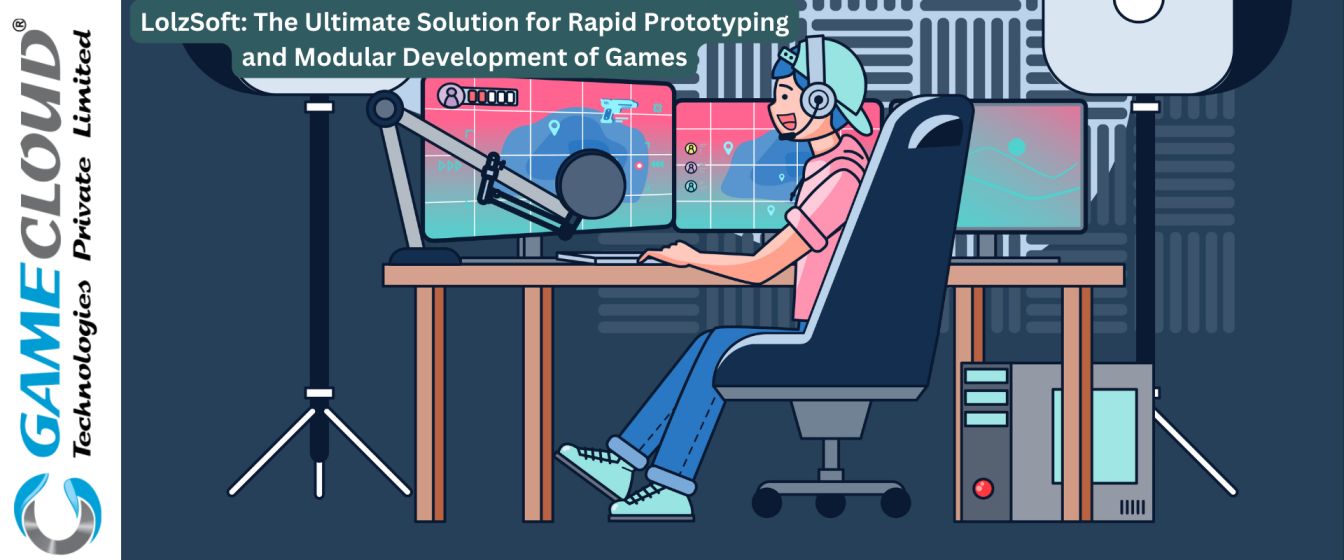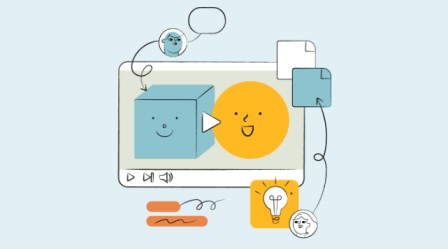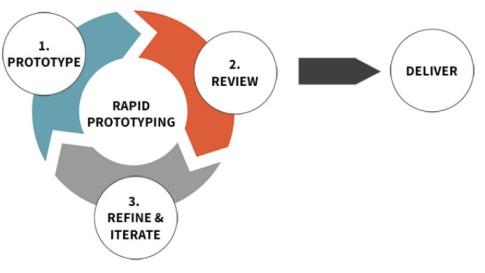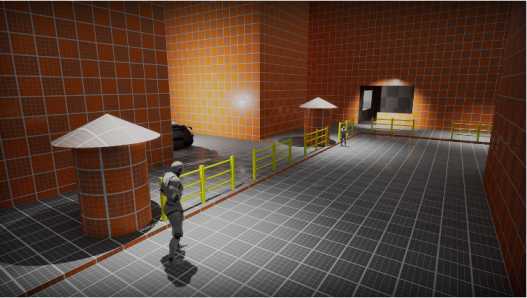
LolzSoft, an independent division of GameCloud Technologies Private Limited, distinguishes itself as a leading work-for-hire studio dedicated to providing Business-to-Business (B2B) services within the video games industry. As a specialized entity, LolzSoft is committed to delivering rapid prototyping and modular development solutions, enabling game developers around the globe to enhance their development processes significantly. The advent of LolzSoft has addressed and mitigated the considerable challenges traditionally faced by game studios during the early stages of game development. Through its bespoke services, LolzSoft meets the critical needs of developers striving for increased speed and flexibility in their game creation endeavors. Utilizing LolzSoft’s expertise, game developers can swiftly transition their ideas into prototypes and efficiently implement modular designs, thus streamlining their development cycles and achieving greater productivity.
Rapid Prototyping in Game Development
Rapid prototyping in game development is an iterative technique used to create basic samples or models of game ideas and design features. The main goals of rapid game prototyping are to validate ideas, test gameplay mechanics, and gather user feedback. This process helps developers refine their design choices and create immersive games that appeal to players. Rapid game prototyping involves several phases: ideation, prototype creation, testing and feedback, iteration and refinement, validation and decision-making, and the production phase.
Some tools and technologies commonly used in rapid game prototyping include game engines like Unity or Unreal, visual scripting languages like PlayMaker or Blueprints, and online platforms like Construct or Scratch. Rapid prototyping has several advantages, such as faster concept validation and iteration, enhanced collaboration and communication, cost and time efficiency, risk mitigation, iterative improvement, and player-centric design.

Current trends and innovations in game prototyping include digital prototyping using software tools, modular prototyping, data-driven prototyping, interactive prototyping, and generative prototyping. These approaches help developers create effective prototypes that can be tested, iterated, and refined to create engaging and successful games. Some current trends and innovations in game prototyping include:
- Rapid Prototyping: Creating quick and simple versions of game concepts using tools and techniques that are easy to learn and use. This can help validate assumptions and experiment with different features.
- Modular Prototyping: Building your game prototype from reusable and interchangeable components. This can save time and effort by reusing existing modules for different prototypes or combining them in new ways to create new features or variations.
- Data-Driven Prototyping: Using data and analytics to inform game design decisions and optimise prototypes. This can help measure the performance and impact of your prototype, such as how players interact with it, what they like or dislike, or what problems or opportunities they encounter.
- Interactive Prototyping: Creating prototypes that can respond to user input and feedback, such as gestures, voice, or emotions. This can help create more immersive and engaging experiences for players.
- Generative Prototyping: Using AI, readymade assets and rules to generate content or variations for your game prototype, such as levels, art, models, enemies, in-game items, environmental backgrounds, or narratives. This can help rapidly create more diverse and dynamic prototypes.
How can rapid prototyping help in identifying game mechanics
Rapid prototyping plays a crucial role in identifying game mechanics by providing developers with a tangible way to test and iterate on their ideas quickly. By creating basic samples or models of game concepts, developers can visualise how different mechanics interact, assess their functionality, and gather feedback from users early in the development process. This approach allows developers to experiment with various gameplay mechanics, such as movement, combat systems, puzzles, or resource management, and observe how these mechanics impact the overall gaming experience.
Through rapid prototyping, developers can test the feasibility and effectiveness of different game mechanics in a practical setting. By building simple prototypes that prioritise utility over visual refinement, developers can focus on the core gameplay elements and mechanics without getting bogged down in unnecessary details. Testing these prototypes with users helps identify potential flaws, improvements, or areas where mechanics may need adjustment to enhance player engagement and enjoyment.
The iterative nature of rapid prototyping enables developers to refine and enhance game mechanics based on user feedback and testing results. This iterative process involves creating prototypes, testing them, gathering feedback, making adjustments, and repeating the cycle until the desired gameplay experience is achieved. By rapidly iterating on game mechanics through prototyping, developers can save time and resources by addressing issues early in the development cycle and ultimately create more engaging and immersive games that resonate with players. Here are some common game mechanics that can be identified through rapid prototyping:
- Movement Mechanics: Movement mechanics involve how characters or objects move within the game world. Rapid prototyping can help identify the most intuitive and enjoyable movement mechanics by testing various controls, movement speeds, and obstacles.
- Combat Mechanics: Combat mechanics involve the interactions between characters or objects during conflicts. Rapid prototyping can help identify the most balanced and engaging combat systems by testing different attack and defence mechanics, weapon designs, and enemy behaviours.
- Puzzle Mechanics: Puzzle mechanics involve problem-solving elements that challenge players to think critically and creatively. Rapid prototyping can help identify the most engaging and challenging puzzle mechanics by testing different puzzle types, difficulty levels, and hint systems.
- Resource Management Mechanics: Resource management mechanics involve the allocation and management of resources within the game world. Rapid prototyping can help identify the most strategic and engaging resource management systems by testing different resource types, collection methods, and spending mechanics.
- Narrative Mechanics: Narrative mechanics involve the storytelling elements within the game, such as dialogue, cutscenes, and character interactions. Rapid prototyping can help identify the most engaging and immersive narrative mechanics by testing different dialogue systems, story structures, and character development methods.
Benefits & Challenges of Rapid Prototyping in Game Development
Rapid prototyping in game development offers a multitude of benefits that significantly impact the efficiency and success of the development process. One key advantage is the ability to save time and money by quickly creating prototypes using readymade assets & AI, allowing for rapid iteration and refinement of designs at a faster pace. This accelerated process reduces time-to-market, giving developers a competitive edge in the industry while ensuring that the final product meets or exceeds customer expectations.
Another crucial benefit of rapid prototyping is the opportunity to test the functionality and performance of a game before mass production. By creating physical prototypes, developers can evaluate aspects like ergonomics, fit, and function, identifying any potential flaws or areas for improvement early on in the development cycle. This iterative process enables continuous improvement, leading to a final product that resonates with players and delivers an immersive gaming experience.
Effective communication and collaboration are also enhanced through rapid prototyping in game development. The game prototypes serve as visual representations that help team members, stakeholders, and potential participants better understand and contribute to the product concept. This fosters clearer communication, reduces misunderstandings, and creates a collaborative environment where ideas can be shared and refined effectively. By leveraging these benefits, developers can streamline the development process, mitigate risks, and create innovative and engaging games that captivate players and stand out in the competitive gaming industry.
Rapid prototyping in game development, while highly beneficial, also presents several challenges that developers may encounter during the process. One significant challenge is the balance between speed and completeness when creating prototypes. While the goal is to create quick iterations for testing, there is a risk of overlooking essential details or features that could impact the overall gameplay experience.
Another challenge of rapid prototyping in game development is the potential lack of holistic understanding or clarity in the early stages of prototyping. Building prototypes on paper may result in a limited view of the game state while using game engines like Unity can lead to incomplete representations due to placeholders and basic assets. This challenge highlights the importance of a clear prototyping vision and strategy.
Furthermore, the availability and proficiency of prototyping tools can pose a challenge in rapid game development. While there are various tools and technologies available for rapid prototyping, selecting the right tools that align with the project’s requirements and the team’s expertise can be crucial. Additionally, some tools may lack specialised features for specific aspects of game design, such as dialogue writing or creating complex interactions, which can hinder the prototyping process.

Strategies to Overcome Challenges of Rapid Prototyping in Game Development
To overcome the challenges of rapid prototyping in game development, developers can implement various strategies that enhance the efficiency and effectiveness of the prototyping process. One key strategy is to leverage existing game engines like Unity, Unreal, or Godot, which provide robust tools and frameworks for creating prototypes without starting from scratch. These engines offer a wide range of features and functionalities that can expedite the prototyping process and allow developers to focus on testing gameplay mechanics rather than building complex systems from the ground up.
Another effective strategy is to use placeholder graphics instead of polished final assets during prototyping. By utilising simple shapes or “programmer art,” developers can quickly visualise game elements without getting bogged down in detailed graphics. This approach helps maintain focus on core gameplay mechanics and ensures that developers can iterate rapidly without being hindered by the need for elaborate visual assets.
Scripting languages like C#, Python, Lua, or Verse can also be valuable tools for rapidly prototyping game behaviours. These languages enable developers to script game mechanics quickly and efficiently, allowing for rapid iteration and testing of different gameplay elements.
Additionally, incorporating reusable components and pre-built tools into the prototyping workflow can significantly speed up development. By utilising existing components or tools, developers can save time on repetitive tasks and focus on refining gameplay mechanics and user experiences. This approach enhances productivity and allows for more efficient iteration of game prototypes, ultimately leading to better-informed design decisions and more engaging gameplay experiences.
By implementing these strategies and leveraging the resources available for rapid prototyping in game development, developers can overcome challenges effectively, streamline the prototyping process, and create innovative and immersive games that resonate with players. To avoid common mistakes when rapid prototyping in game development, consider the following strategies:
- Define the Scope: Clearly define the scope of your prototype, focusing on the core gameplay mechanics and user experience. Avoid trying to create a complete game in the prototype stage, as this can lead to unnecessary complexity and delays.
- Embrace Failure: Recognise that most prototypes will be “failed” games, and use this as an opportunity to learn and iterate. Embrace experimentation and be willing to pivot or abandon ideas that don’t work.
- Iterate Rapidly: Continuously evaluate and refine your prototype based on feedback and results. Be prepared to make changes quickly and frequently to improve the gameplay experience.
- Manage Tweakables: Keep adjustments to the game in one place, using clear and linear effects to make fine-tuning easier.
- Focus on Core Mechanics: Prioritise the core gameplay elements, ensuring that the prototype emphasises these mechanics over graphics or storylines.
Modular Development of Games
The ultimate solution for the modular development of games involves implementing strategies that focus on creating elegant, extensible, and reusable systems in game programming. One approach is to adopt the object/component model, a design pattern that emphasises modularity and flexibility in game development. This model allows for the creation of game objects by composing them of components, enabling developers to build games with reusable and interchangeable parts. By utilising this approach, developers can easily share components, create custom plugins, and collaborate on game projects more effectively.
Another crucial aspect of modular game development is designing scalable and modular 3D game engines or frameworks. To achieve this, developers should define clear goals and requirements for their engine, prioritise essential features, and consider trade-offs between complexity and performance. Using a modular and layered architecture helps in dividing code into independent components with well-defined interfaces, reducing dependencies and increasing maintainability.
Furthermore, deploying design patterns like the entity-component-system (ECS), event-driven pattern, singleton pattern, factory pattern, observer pattern, command pattern, state pattern, and strategy pattern can enhance the flexibility and dynamism of game objects while promoting code reusability and maintainability. These patterns provide solutions to common problems in software development and help in creating robust and adaptable game systems.

Modular game development offers a range of benefits that significantly enhance the efficiency and quality of game development processes. Some key advantages include:
- Code Quality: Modularisation increases code quality by creating distinct, reusable, and easily understandable modules within a project. This approach enhances the readability, reliability, and robustness of the codebase, making it easier to manage and maintain.
- Debugging Ease: Modular development simplifies debugging by breaking down classes into smaller, more manageable components. This structure allows developers to identify and address issues more efficiently, as they can isolate problems to specific modules or components.
- Reusability: Modular code is highly reusable, which is crucial in game development where quick delivery of new games is essential. By reusing common components across projects, developers can save time and effort, accelerating the development process.
- Readability: Modularisation increases code readability by organising pieces based on their responsibilities or tasks. This organisation makes it easier for developers to understand the codebase, reducing the time spent on deciphering complex structures.
How does modular game development improve code maintainability?
Modular game development improves code maintainability by breaking down a game into smaller, interchangeable components that can be easily modified or replaced. This approach simplifies development, updates, bug fixes, and the introduction of new features. To ensure game modularity, developers should implement clear interfaces between components, use consistent standards and conventions, and define clear responsibilities for each module.
Modular design allows for reduced complexity, improved readability, enhanced reusability, and facilitated testing and debugging of game code. By organising game code into smaller, independent modules, developers can more easily maintain and scale their projects. Modularisation also increases code quality by creating modular pieces in a project, which can be easily seen and reused. This approach creates a base for quality code, making it easier to debug, reusable, and more reliable.
How does modular game development improve collaboration between game developers?
Modular game development improves collaboration between game developers by enabling them to work on different game components without interfering with each other’s work. This approach reduces the likelihood of conflicts and issues that can slow down the team. By dividing the game into smaller, interchangeable components, developers can work on specific modules in parallel, allowing for more efficient collaboration and faster development.
Modular game development also promotes clear interfaces and public APIs between modules, ensuring that everything fits together seamlessly at deployment. This structure allows developers to assign ownership to specific modules of code, ensuring that teams are responsible for their part of the software and can break the work down into smaller tasks.
In addition, modular game development can lead to a flood of new game concepts and mechanics that game teams can leverage, as well as improvements in quality assurance and testing processes. AI tools can also be used to design game environments and improve testing processes, further enhancing collaboration between game developers.
Conclusion
Rapid prototyping and modular development are essential components of game development, allowing developers to create engaging and immersive games efficiently. Rapid prototyping helps in testing gameplay mechanics, validating ideas, and gathering user feedback, while modular development promotes code reusability, maintainability, and collaboration. They are the ultimate solutions for creating engaging and immersive games efficiently. By embracing these approaches, developers can save time, reduce costs, and create high-quality games that resonate with players.
